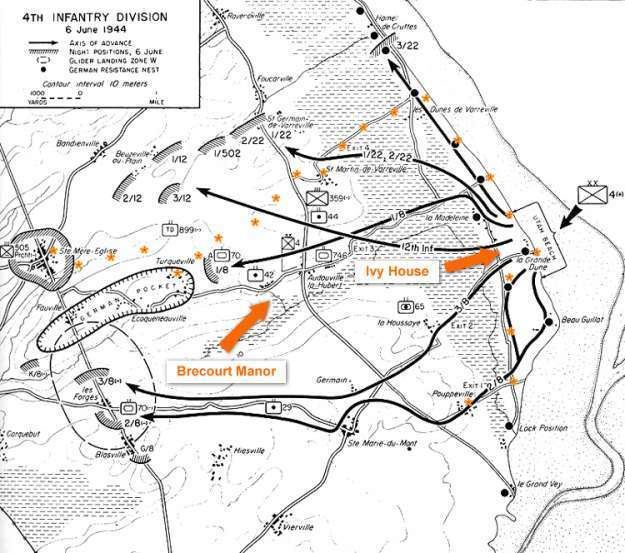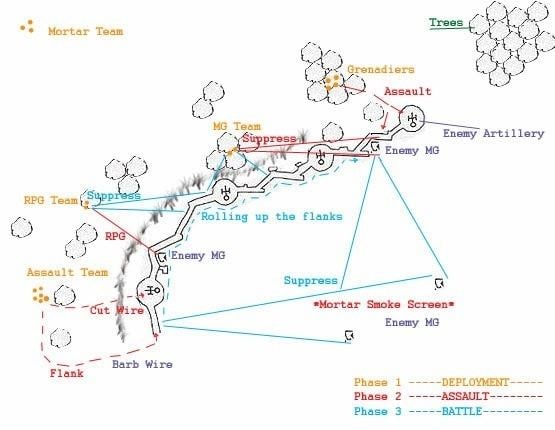Date 6 June 1944 | Result Tactical Allied victory | |
 | ||
Similar World War II, Battle of Carentan, Invasion of Normandy, Battle of Bloody Gulch, Pointe du Hoc | ||
Br court manor assault
The Brécourt Manor Assault (6 June 1944) during the U.S. parachute assault of the Normandy Invasion of World War II is often cited as a classic example of small-unit tactics and leadership in overcoming a larger enemy force.
Contents

Objective
Command of Company E, 2nd Battalion, 506th Parachute Infantry Regiment of the 101st Airborne Division had temporarily fallen to executive officer, 1st Lt. Richard Winters. After linking up with his parent unit at the hamlet of Le Grand Chemin on the morning of 6 June 1944, Winters was ordered up front away from his company. With minimal instructions of "There's fire along that hedgerow there. Take care of it," and no briefing, Winters found himself given the task of destroying a German artillery battery. The battery had initially been reported to be 88 mm guns firing onto causeway exit #2 leading off Utah Beach and disrupting landing forces of the U.S. 4th Infantry Division advancing inland on this route. Several other units had stumbled onto the German position earlier in the morning and had been repulsed.

Winters undertook a reconnaissance at about 0830, after which he collected a team of 12 men from his own and other companies. Beyond knowledge of the general location of the gun emplacements south of Le Grand Chemin and without information of the other side of the hedgerow, Winters' team attacked Brécourt Manor, located three miles southwest of Utah Beach and north of the village of Sainte-Marie-du-Mont. There he discovered No. 6 Battery of the 90th Artillery Regiment, consisting of four 105 mm howitzers connected by trenches and defended by a company of soldiers.

Winters held that the unit was part of the 6th Fallschirmjägerregiment ("6th Parachute Regiment") with emplaced MG42 machine guns. The 1st battalion of the 6th had been ordered to Sainte Marie-du-Mont from Carentan during the afternoon but arrived after dark. The 1st Company 919th Grenadier Regiment (709th Infantry Division) was posted at Sainte Marie-du-Mont and was responsible for the area. Elements of 1058th Grenadier Regiment (91st Luftlandedivision) were defending throughout the vicinity, and the artillery was part of this division also. The 795th Georgian Battalion, attached to the 709th ID, was to the northwest at Turqueville but is less likely to have been present because of terrain difficulties. Whichever unit defended the battery, the U.S. paratroopers were opposed by approximately sixty German soldiers.
The crew originally assigned to the four 105mm guns had apparently deserted during the night of the airborne landings. Oberstleutnant Friedrich von der Heydte of the German 6th Parachute Regiment, upon discovering they had been abandoned while observing the landings at Utah Beach, traveled to Carentan where he ordered his 1st Battalion to occupy and hold Sainte-Marie-du-Mont and Brécourt, and find men to work on the artillery battery.
Battle
Upon arrival at the battery location, Winters made his plan: he positioned a pair of M1919 machine guns for covering fire and sent several soldiers (2d Lt. Lynn D. Compton, Pvt. Donald Malarkey and Sgt. William J. Guarnere) to one flank to destroy a machine gun position with grenades and provide covering fire.
While the trenches connecting the artillery positions provided the Germans with an easy way to supply and reinforce the guns, they also proved to be their biggest weakness. After destroying the first gun position, Winters and the rest of his team used the trenches as covered approaches to attack the remaining guns in turn. Each gun was destroyed by placing a block of TNT down its barrel and using German stick grenades to set off the charges.
Reinforcements from Company D, led by 2d Lt. Ronald C. Speirs, arrived to complete the assault on the fourth and last gun. Speirs had a reputation as an excellent and extremely aggressive officer, and he led his men against the last gun position by running outside the trenches, exposing himself to enemy fire.
After the four guns were disabled, Winters' team came under heavy machine-gun fire from Brécourt Manor and withdrew. He had discovered a German map in one gun position that was marked with the locations of all German artillery and machine gun positions throughout that area of the Cotentin Peninsula. This was an invaluable piece of intelligence, and once Winters returned to Le Grand Chemin, he passed it on to the 2nd Battalion intelligence officer (S-2) (and close personal friend) 1st Lt. Lewis Nixon. Nixon, realizing this to be an essential piece of intelligence, ran the three miles to Utah Beach and passed the information up the chain of command. Command was so thrilled with the information provided by Nixon and Winters that it sent the first two tanks to reach Utah Beach to support the paratroopers.
Winters also directed the fire of two American tanks which arrived later from Utah Beach to eliminate remaining German resistance.
Winters lost one man, Pfc. John D. Halls (of A Company) from an 81mm mortar platoon, and Private Robert "Popeye" Wynn was wounded during the attack. Another casualty was Warrant Officer Andrew Hill, who was killed when he came upon the battle while searching for the headquarters of the 506th PIR. Sgt. "Rusty" Houck from F Company, who was with Speirs, was killed as well. One soldier from D Company under Speirs' command was also killed, as well as one soldier wounded from D Company.
Aftermath
Troops landing at Utah Beach had a relatively easy landing, due in part to this successful assault. Colonel Robert Sink, the commander of the 506th PIR, recommended Winters for the Medal of Honor, but the award was downgraded to the Distinguished Service Cross due to the policy of only one Medal of Honor awarded per division, which was awarded to Lieutenant Colonel Robert G. Cole. There was a campaign to upgrade Winters' Distinguished Service Cross to the Medal of Honor as many felt he deserved, but the bill to award the Medal of Honor to Winters, H.R. 796, died in committee at the end of the 110th United States Congress and has not been reintroduced since by its sponsor, Tim Holden.
The official Army history of these events on D-Day is quiet about the battle. Army historian S. L. A. Marshall interviewed Winters about the attack, but the interview was not private – many of Winters' superior officers were present – and, according to his memoir Beyond Band of Brothers, he may have downplayed his description of the event to avoid personal accolade and to keep the account succinct. In fact, Marshall stated in his report that Winters had about two hundred men under his command. However, nearly every man involved was later recognized for his role in the attack.
A documentary produced by filmmaker and trial attorney Vance Day titled "The Battle at Brecourt Manor" was premiered in August 2010 in Salem, Oregon during an event for Donald Malarkey who served in Easy Company and during the engagement at Brecourt Manor. Day is a good friend of Malarkey's and the two traveled extensively to conduct Frontline Leadership seminars around the country, primarily for law enforcement, military, and leadership organizations. Lynn "Buck" Compton also was regularly involved in both events for Frontline Leadership and "The Battle at Brecourt Manor" showings.
Medals awarded
Distinguished Service Cross
Silver Star
Bronze Star
Purple Heart
